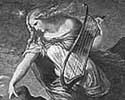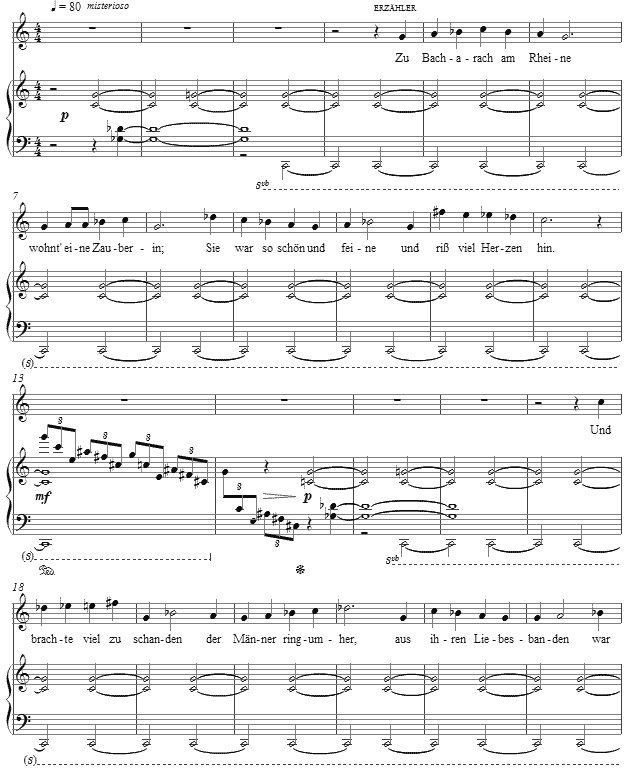Music and Texts of GARY BACHLUND
Vocal Music | Piano | Organ | Chamber Music | Orchestral | Articles and Commentary | Poems and Stories | Miscellany | FAQs
Lore Lay - (1995)
Clemens Brentano
for mezzo soprano and piano or chamber orchestra
for Kathrin Bechstein
Zu Bacharach am Rheine
Wohnt' eine Zauberin
Sie war so schön und feine
Und riß viel Herzen hin.
Und brachte viel zu Schanden
Der Männer ringsumher;
Aus ihren Liebesbanden
War keine Rettung mehr.
Der Bischof ließ sie laden
Vor geistliche Gewalt
Und mußte sie begnaden,
So schön war ihr' Gestalt.
Er sprach zu ihr gerühret:
"Du arme Lore Lay!
Wer hat dich denn verführet
Zu böser Zauberei?" -
"Herr Bischof, laßt mich sterben!
Ich bin des Lebens müd,
Weil jeder muß verderben,
Der meine Augen sieht!
Die Augen sind zwei Flammen,
Mein Arm ein Zauberstab -
O legt mich in die Flammen,
O brechet mir den Stab!" -
"Ich kann dich nicht verdammen,
Bis du mir erst bekennt
Warum in deinen Flammen
Mein eignes Herz schon brennt.
Den Stab kann ich nicht brechen
Du schöne Lore Lay!
Ich müßte denn zerbrechen
Mein eigen Herz entzwei!"
"Herr Bischof, mit mir Armen
Treibt nicht so bösen Spott
Und bittet um Erbarmen
Für mich den lieben Gott!
Ich darf nicht länger leben,
Ich liebe keinen mehr. -
Den Tod sollt Ihr mir geben,
Drum kam ich zu Euch her!
Mein Schatz hat mich betrogen,
Hat sich von mir gewandt,
Ist fort von mir gezogen,
Fort in ein fremdes Land.
Die Augen sanft und wilde,
Die Wangen rot und weiß,
Die Worte still und milde,
Das ist mein Zauberkreis.
Ich selbst muß drin verderben,
Das Herz tut mir so weh;
Vor Schmerzen möcht ich sterben,
Wenn ich mein Bildnis seh.
Drum laßt mein Recht mich finden,
Mich sterben wie ein Christ,
Denn alles muß verschwinden,
Weil er nicht bei mir ist! "
Drei Ritter läßt er holen:
"Bringt sie ins Kloster hin!
Geh, Lore! - Gott befohlen
Sei dein berückter Sinn!
Du sollst ein Nönnchen werden,
Ein Nönnchen schwarz und weiß,
Bereite dich auf Erden
Zu deines Todes Reis'!"
Zum Kloster sie nun ritten,
Die Ritter alle drei,
Und traurig in der Mitten
Die schöne Lore Lay.
"O Ritter, laßt mich gehen
Auf diesen Felsen groß,
Ich will noch einmal sehen
Nach meines Lieben Schloß.
Ich will noch einmal sehen
Wohl in den tiefen Rhein
Und dann ins Kloster gehen
Und Gottes Jungfrau sein."
Der Felsen ist so jähe,
So steil ist seine Wand,
Doch klimmt sie in die Höhe,
Bis daß sie oben stand.
Es binden die drei Reiter
Die Rosse unten an
Und klettern immer weiter
Zum Felsen auch hinan.
Die Jungfrau sprach: "Da gehet
Ein Schifflein auf dem Rhein;
Der in dem Schifflein stehet,
Der soll mein Liebster sein!
Mein Herz wird mir so munter,
Er muß mein Liebster sein!" -
Da lehnt sie sich hinunter
Und stürzet in den Rhein.
Die Ritter mußten sterben,
Sie konnten nicht hinab;
Sie mußten all verderben
Ohn Priester und ohn Grab.
Wer hat dies Lied gesungen?
Ein Schiffer auf dem Rhein,
Und immer hat's geklungen
Von dem Dreiritterstein:
Lore Lay! Lore Lay! Lore Lay!
Als wären es meiner drei.
[ 16 pages, circa 12' 00" ]

Clemens Brentano
Clemens Brentano (September 8, 1778 - July 28, 1842) was a German poet and novelist of the romantic school, of Italian descent. His sister was Bettina von Arnim, Goethe's correspondent. While studying at Halle and Jena he met Wieland, Herder, and Goethe, but his sympathy lay with the younger German romantics. Later he lived in Heidelberg, Vienna and Berlin. Brentano, whose early writings were published under the pseudonym Maria, belonged to the Heidelberg group of German romantic writers, and his works are marked by excess of fantastic imagery and by abrupt, bizarre modes of expression. With Achim von Arnim he collaborated on Des Knaben Wunderhorn (1806–1808), a folk-song collection that influenced Eichendorff, Heine, the brothers Grimm and several composers, notably Mahler. His first published writings were Satiren und poetische Spiele (1800), and a romance Godwi (1801-1802) from which the "Lore Lay" comes; of his dramas the best are Ponce de Leon (1804), Victoria (1817) and Die Grundung Prags (1815). Brentano wrote plays, lyric poems, fairy tales, and such novellas as Geschichte vom braven Kasperl und dem schönen Annerl (1817, tr. The Story of the Just Casper and Fair Annie, 1927). Brentano's collected works, edited by his brother Christian, appeared at Frankfurt in 9 vols. (1851-1855)
The Lorelei is a large rock on the bank of the Rhine River near St. Goarshausen. The hill and rock above create an echo now associated with the maiden who threw herself into the river in despair over a faithless lover, and was transformed into a siren who lured fishermen to their death, as in the picture above. Heinrich Heine's much shorter poem on the same myth has been set to music by over 25 composers. Brentano claimed his version containing the essential elements of the myth was invented by him, in Godwi.
Near Bacharach on the Rhine
lived a witch.
She was so beautiful and fine,
and seduced many hearts.
And she brought many men
to shame all around her;
From her love's bindings
there was no rescue.
The bishop wished to summon
her for a spiritual accounting
where she would plead,
so firm was his resolve.
He said to her calmly:
"You poor Lore Lay!
Who has seduced you into
such evil witchcraft?"
"Lord Bishop, let me die!
I am weary of life,
because all who my eyes see
must be despoiled!
My eyes are two flames,
my arms a magic wand.
Oh, lie me down in the flames,
oh, break you crosier [on me]."
"I cannot condemn you to damnation,
because you have admitted to me
why my own heart already burns
in your flames.
I cannot break my crosier on you,
you beauteous Lore Lay!
I must therefore
break my own heart in two!"
"Lord Bishop, do not so unhappily
mock me with your arms,
and pray for my salvation
to your beloved God!
I must not live longer,
for I love no more.
Death that you can give me
is the reason I came to you!
My treasures have deceived me,
so skillfully have they
been drawn away from me,
drawn into a strange land.
My eyes so soft and wild,
my cheeks so red and white,
my words so still and mild,
These are my magic spells.
I must myself despoil,
my heart gives me such pain;
From pain I would die,
when I see my own image.
So let me find my right path,
to die like a Christ,
then all must pass away,
because He will not be with me!"
He fetched three knights:
"Bring her to a cloister!
Go, Lore Lay -- God has commanded
your enchanted lust!
You shall become a nun,
a nun in black and white,
to become ready here on earth
for your final end!"
To the cloister she was being taken
by all three knights,
with the beauteous Lore Lay so sad in their company.
"Oh knights, let me go
to the top of this great cliff,
I would once more look on
my love's castle.
I would once more look
deep into the Rhine
and then go to the cloister
to become God's bride."
The cliff is so steep,
so precipitous is its wall,
and yet she climbed into the heights,
to stand there at the top.
The three knights
tied their horses at the bottom,
and clambered up the heights
towards the top of the cliff.
The maiden spoke: "There comes
a boat along the Rhine;
there is the boat stands
one who will be my love!
My heart will become merry,
as he will be my love!"
As so she leaned down
and leapt into the Rhine.
The knights must themselves die,
not able to return;
She did all despoil
without priest or grave.
Who has sung this song?
A sailor on the Rhine,
and always it has echoed
from the Three-Knights-rock:
Lore Lay! Lore Lay! Lore Lay!
As had my three....
Brentano creates a cast of characters which a single singer must portray -- the storyteller, Lore Lay and the Bishop -- and the setting is a harmonic structure in which, beginning with the tri-tone relationship between C major and F-sharp major (the so-called "devil in music") and with the upper and lower harmonies proceeding in opposite directions around the circle of fifths, to capture this strange and magical story. A map of this polytonal strategy follows, the lower regions being the circle of fifths in the opposite direction from the upper tonal regions:
The vocal line is wholly octatonic, each whole step followed by a half-step thereby making an eight note scale within the octave rather than the seven which make up pure diatonicism. Thus the vocal line refers easily to the various polytonal regions, as they shift from dramatic section to section.
Kathrin Bechstein
This setting of the famous Lorelei myth is dedicated to Kathrin Bechstein, who had sung the Shepherd our production of Tannhäuser which opened the new Pfalztheater in Kaiserslautern, Germany. During rehearsals, she had told me of her appreciation for this particular retelling of the myth, which has been retold by many poets and storytellers through centuries.
The score for Lore Lay is available as a free PDF download, though any major commercial performance or recording of the work is prohibited without prior arrangement with the composer. Click on the graphic below for this piano-vocal score. For the orchestral score, please contact me via email through the address found under "Miscellany."


